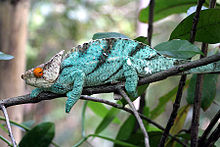Calumma parsonii
| Parson's chameleon | |
|---|---|
 |
|
| Male C. p. parsonii, "orange eye" variant |
|
| Scientific classification | |
| Kingdom: | Animalia |
| Phylum: | Chordata |
| Subphylum: | Vertebrata |
| Class: | Reptilia |
| Order: | Squamata |
| Suborder: | Lacertilia |
| Infraorder: | Iguania |
| Family: | Chamaeleonidae |
| Subfamily: | Chamaeleoninae |
| Genus: | Calumma |
| Species: | C. parsonii |
| Binomial name | |
|
Calumma parsonii (Cuvier, 1824) |
|
 |
|
| Synonyms | |
|
|
Parson's chameleon (Calumma parsonii) is a large species of chameleon that is endemic to isolated pockets of humid primary forest in eastern and northern Madagascar. It is listed on CITES Appendix II, meaning that trade in this species is regulated. As with the majority of chameleon species from Madagascar, it is illegal to export Parson's chameleons from their native country.
The specific name, parsonii, is in honor of British physician James Parsons.
Among the largest chameleons in the world (variously reported as either the largest, or second-largest after the Malagasy Giant Chameleon), C. parsonii males have ridges running from above the eyes to the nose, forming two warty horns. There are two recognized subspecies: The widespread Calumma p. parsonii reaches up to 68 cm (27 in) in total length (including tail), about the size of a cat, and has no dorsal crest. Calumma p. cristifer, from near Andasibe, reaches 47 cm (18 1⁄2 in), and has a small dorsal crest. Several colour variants are known within the range typically included in the nominate subspecies, but it is unclear if they are best considered morphs or different subspecies (at present, most consider them morphs). This includes "orange eye" aka "white-lipped" (generally considered typical of the nominate subspecies), where the male is relatively small and mainly green or turquoise but with yellow or orange eyelids; "yellow lip" where the male is somewhat larger and mainly green or turquoise, but with a yellow edge to the mouth; "yellow giant" where the male is very large and overall yellowish (strongly marked with dusky when stressed); and "green giant" where the male is overall green. Males of C. p. cristifer are overall green or turquoise. Females of both subspecies are smaller than the males and overall greenish, yellowish or brownish (often with an orange tinge).
...
Wikipedia

